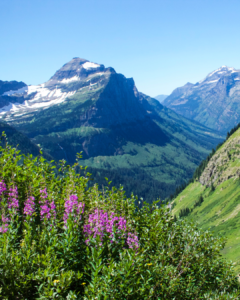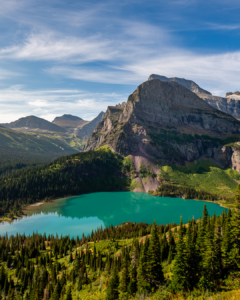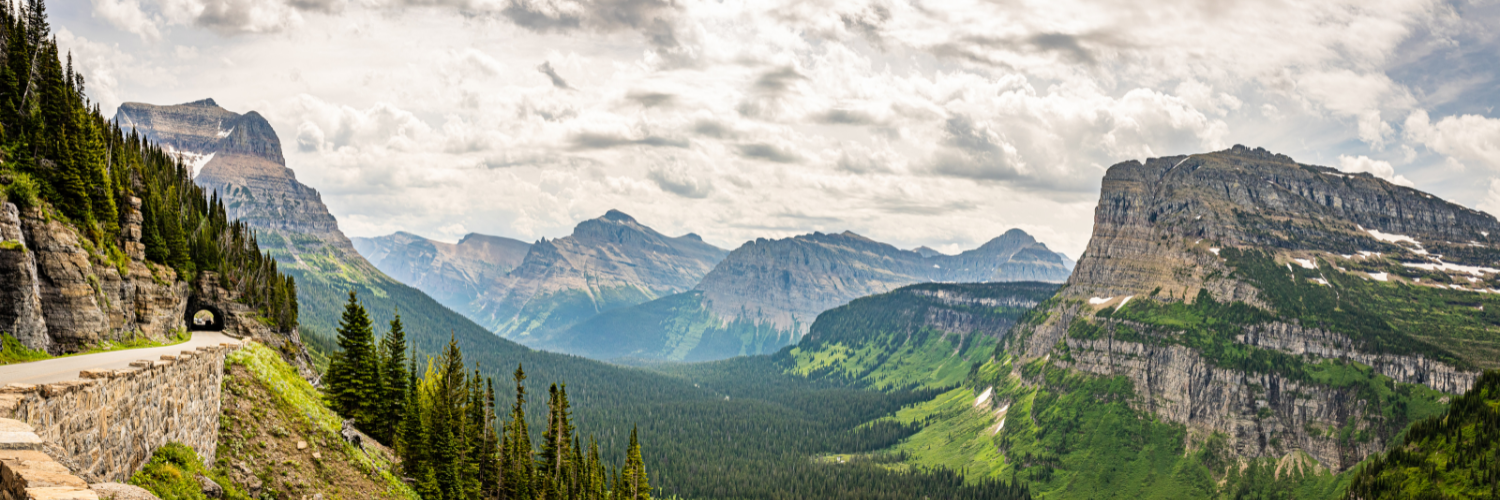Lynn Scarlett is a member of the Salazar Center’s External Advisory Board. She is the former Deputy Secretary of the Interior and served as the Global Chief External Affairs Officer for The Nature Conservancy.
Some years ago, while I was Deputy Secretary at the Department of the Interior, I hiked a stretch of trail in Glacier National Park. With others, I then hiked another stretch, crossing the border into Waterton National Park. I savored the magnificence of these two places. I savored the vistas of craggy peaks, the aquamarine glacial lakes, the wetlands rich in wildlife, the meadows golden and shimmering in the wind. I tasted berries, ripe and perfumed. I saw grizzlies—far off across the hillside.

I celebrate the significance of these parks. I celebrate the significance of the partnerships among people, organizations, and governments to lend a caring hand to these places.
Later, after my hikes, I visited ranchers, firefighters, bear biologists, local community leaders, and Tribal and First Nation peoples whose knowledge, lives and livelihoods are linked to lands and waters along this Crown of the Continent. These people, their neighbors, and partners are all engaged in increasingly linked social, environmental, and economic enterprises. These enterprises enhance—not merely sustain—lands, communities, and economies. They enhance resilience in the context of a changing climate. They augment many voices and tap the knowledge of diverse peoples.
These collaborative efforts in large landscape conservation are not easy, but these ventures are broadening across the continent. While I served for nearly 8 years at the U.S Interior Department—first as Assistant Secretary, then as Deputy Secretary—I was privileged to meet with diverse people along the Duck Trap River in Maine, along Winyah Bay in South Carolina, at Las Cienegas in Arizona, the Swan Valley in Montana, and so many other places. Later, in my role at The Nature Conservancy, I met with conservation partners in the Yucatan Peninsula and elsewhere. At each of these places, I spoke with people clustered in constellations of collaboration to conserve places, enhance communities, and strengthen social equity.
As I contemplate this efflorescence of action, this emergence of organizations and their interconnections into larger networks, I am reminded of the words of former US Secretary of the Interior Steward Udall. I am, he said, “a troubled optimist.” As I contemplate communities, conservation, climate action, and landscape-scale collaboration, I guess I, too, am a troubled optimist. I am troubled because the issues are increasingly complex. Headlines of wildland fires and the extent of smoke they generate remind us that the scope of challenges can transcend jurisdictional and property boundaries. The pace of change quickens. Climate change and its effects on land, water, wildlife, and people are vast and varied. Land fragmentation, invasive weeds, water quality and availability, the quest for energy, and the travails of succeeding in a global economy, even the survival of languages and stories and cultures, all challenge us.
Over 100 years ago, scientist and explorer John Wesley Powell observed the intersection of people and nature with a systems lens. Observing interdependencies and interconnections, he concluded: “People must necessarily work together for common purposes within interconnected spaces and places.” Fast forward 120 years, and we see a growing embrace of this vision of interconnections of both people and places. For the past two decades, many communities—in Canada, the United States, and Mexico—reflect what Abraham Lincoln once called “the better angels of our Nature”—our capacity to find common ground in communities as people engage in increasingly linked endeavors to enhance climate resilience, conservation, and social equity. Communities are coalescing in partnered problem solving at larger and larger scales.
It is these efforts that the Salazar Center embraces and is accelerating through symposia and networking and knowledge-building. Through dialogue, the Center explores nature-positive solutions that broaden conservation and climate action to encompass whole ecosystems and engage diverse communities.
In these efforts, we see a deepening recognition that sustaining and restoring natural systems is essential. Nature provides services—water purification, coastal storm surge mitigation, flood protection, temperature regulation, climate change mitigation, and much more. This value invites us to reshape resource management questions. Where and how does reforestation or protection achieve the greatest downstream water quality benefits? How do options for coastal management impact seafood harvest, renewable energy production, and coastal resilience to high-intensity storms? How do agricultural management choices affect the pollination services of nature? What is the implication of thinking about the benefits of nature as we consider conservation priorities, design, and actions?
As we strive, consistent with the Salazar Center mission, “to accelerate the pace and scale of innovative, inclusive, and durable solutions for conservation, climate resilience, and social equity,” what tools and frameworks and decision processes might be relevant? How can we engage in continental opportunities in Mexico, the United States, and Canada?

While collaborative conservation unfolds at many nested scales, sometimes these efforts must consider transboundary linkages. The United States, Canada, and Mexico have intersecting ecosystems, intersecting ecosystem services, and species linked across geographies. Sometimes drivers of environmental change in one country affect the delivery of ecosystem services and human well-being in another country. And the effects of a changing climate span countries.
Climate changes, for example, affect snowpack, the timing of snow melt, precipitation amounts and timing, and temperatures. These can affect the Colorado, Rio Grande and Rio Bravo Rivers, reservoir filling, instream flows, and the timing of life cycle events. All of these, in turn, affect ecosystem functions and the benefits they bring to communities. These interconnecting changes point to the relevance of efforts such as the US-Mexico Transboundary Aquifer Assessment program. They invite us to consider opportunities to think about intersecting Canadian, U.S. and Mexico landscapes, flyways, and waters for wildlife crossings, energy infrastructure, water management, and more.
I see three categories of public policies and decision making important to nurturing efforts in collaborative, large-landscape conservation. First are planning, priority-setting, and evaluation tools like those used in the National Environmental Policy Act in the United States, or the General Ecological Balance and Environmental Protection Act in Mexico, or binational agreements like the Great Lakes Water Quality Agreement. A key consideration is how to extend the boundaries of evaluation beyond individual public land units and how to better consider transboundary issues.Second are regulatory and impact mitigation mechanisms. Conservation banking concepts, for example, provide a potential context for pooling mitigation into large, conserved areas. They have the potential to foster eco-regional or landscape-scale conservation in priority areas. Third are funding programs and other investments that support large-scale, multi-participant efforts. How, for example, might Farm Bill programs in the United States support conservation of high-priority ecosystems, high-value outcomes, greater social equity, and collaborative conservation? Can Farm Bill or other funding programs integrate better with Mexican and Canadian programs?
Salazar Center programs exemplify efforts to facilitate multinational and multiparticipant knowledge-sharing and actions that link people to nature, secure largescale conservation and climate action, and enhance social equity. I have had the great privilege of seeing many relevant efforts across the United States.
I remember a trip a few years ago to western Pennsylvania at Buffalo Creek. There, dozens of farmers, with the Fish and Wildlife Service and a local university, are fencing off miles of streams and riparian areas. They are planting native warm spring grasses. They are installing owl and wood duck boxes, even bat boxes. The results show dramatic reductions of bacteria in water, results that are good for nature—and good for dairy farms. Stream banks now display dense shrubs and brush, bringing habitat for birds and shade cover for fish. But Buffalo Creek manifests another outcome: it is inspiring citizen stewardship.
Twenty-first century conservation success hinges on these collaborative endeavors that benefit people and nature. The tableau, while encouraging, is also a troubled one of deep divides and conflict that can impede investments in science and solutions. But place-based collaborative conservation offers us some hope. These efforts link conservation action to tangible solutions that can benefit all communities. Watershed protection protects drinking water supplies; coastal restoration reduces storm vulnerability, floodplain restoration protects communities, enhancing forest health protects water supplies and reduces risk of catastrophic wildland fires.
Efforts in collaborative conservation remind us that “good decisions” don’t spring merely from “getting the facts straight and getting the science right. Rather, enduring outcomes must be deemed equitable and acceptable to diverse people and communities. A central challenge for conservation is how to provide a rich context for expression of many voices and values—and a means of generating acceptable solutions. This challenge puts a premium on how decision makers—public and private—make choices, communicate information and ideas, and organize and coordinate action. It also puts a premium on knowledge building, yet relevant science is often complex and sometimes uncertain. What will future rainfall patterns be? How will species respond to climate changes?
But there is another dimension of knowledge—local knowledge—that is important to decision making. Collaborative efforts depend upon the knowledge of time, place, circumstance, situation, experience, culture, and tradition. Poet Wallace Stevens once wrote: “Perhaps real truth resides in a walk around the lake.” Local knowledge of experience comes from working and living in communities. Local knowledge helps us define the doable, pinpoint the possible, and think about what’s equitable. Thus, central to collaborative endeavors is how to ensure settings that tap this sort of local knowledge while, also, generating relevant science information. How do collaborative conservation efforts support inclusive dialogue?
Yet assembling all relevant participants is difficult—and involves tremendous investment of time. It also puts a premium on listening. Author William Isaacs once wrote that dialogue is “conversation with a center, not sides.” He added that “to listen is to develop an inner silence.” We must try to see through someone else’s eyes.
I have been in the world of conservation policy, politics, and action for over three decades. Collaborative engagement establishes the building blocks for the politics of problem solving. This does not mean everyone always lines up behind all solutions. But these efforts allow problem-solving conversations to happen—and that is an essential step toward durable success.
The Salazar Center is hosting the fifth annual International Symposium on Conservation Impact on October 11-12 in Denver, Colorado. The agenda focuses on nature-positive solutions and how they can catapult our communities towards durable, high-impact outcomes for climate, biodiversity, and human well-being.
There is an African proverb that goes, “If you want to go fast, go alone. If you want to go far, go together.” We hope that you will join us so we can work together to realize a nature-positive future for North America.

